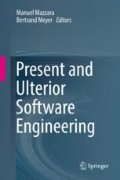Abstract
This short chapter is intended as a briefing on the “state of the practice” of the Unified Modeling Language (UML) and its derivatives and associated languages. It covers the evolution of UML, its near-term future, and some of the languages that have been defined as specializations of UML through a mechanism known as UML profiles. The question of whether all software can be generated through models is briefly addressed, as well as some of the occasionally enlightening comments made by UML experts.
This chapter should not be seen as a “defense of UML,” only as an illustration and discussion. It is not based on original research, but on conversations with peers, especially within the context of the standards development work of the Object Management Group (OMG), which is the custodian of UML and of several related standards. Many researchers and practitioners of software engineering methods have done exhaustive work on the analysis (and the defense when they saw it necessary) of UML; some of their work is mentioned in the references and should definitely be consulted for further information.
Preview
Unable to display preview. Download preview PDF.
References
Object Management Group: Unified Modeling Language™ (UML®) Version 2.5, www.omg.org/spec/UML/2.5/
Whittle, J., et al.: The state of practice in model-driven engineering. IEEE Softw. 31(3), (2013)
Selic, B.: What will it take? A view on adoption of model-based methods in practice. J. Softw. Syst. Model. 11(4), 513–526 (2012). Springer-Verlag
Object Management Group: Semantics of a Foundational Subset for Executable UML Models (fUML™) V1.2.1, www.omg.org/spec/FUML/Current
Object Management Group: UML Testing Profile, http://utp.omg.org/
Baker, P., et al.: Model-Driven Testing – Using the UML Testing Profile. Springer, Berlin (2008)
Object Management Group: OMG Systems Modeling Language™ (SysML®), www.omg.org/spec/SysML/
Object Management Group: Interaction Flow Modeling Language™ (IFML™), www.omg.org/spec/IFML/
Harel, D.: Statecharts: a visual formalism for complex systems. Sci. Comput. Program. 8, 231–274 (1987). North-Holland, www.sciencedirect.com/science/article/pii/0167642387900359
Author information
Authors and Affiliations
Corresponding author
Editor information
Editors and Affiliations
Rights and permissions
Copyright information
© 2017 Springer International Publishing AG
About this chapter
Cite this chapter
Baudoin, C.R. (2017). The Evolution and Ecosystem of the Unified Modeling Language. In: Mazzara, M., Meyer, B. (eds) Present and Ulterior Software Engineering. Springer, Cham. https://doi.org/10.1007/978-3-319-67425-4_3
Download citation
DOI: https://doi.org/10.1007/978-3-319-67425-4_3
Published:
Publisher Name: Springer, Cham
Print ISBN: 978-3-319-67424-7
Online ISBN: 978-3-319-67425-4
eBook Packages: Computer ScienceComputer Science (R0)

